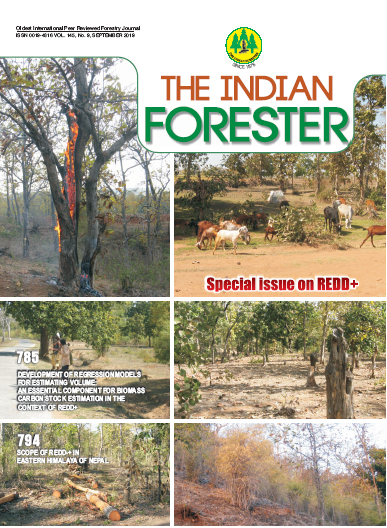Connecting the Integrated Landscape Management Dots for Conserving Carbon Services in Transboundary Landscapes of Hindu Kush Himalaya
DOI:
https://doi.org/10.36808/if/2019/v145i9/148710Keywords:
Transboundary Landscapes, REDD , Carbon, Hindu Kush Himalaya.Abstract
In the context of Hindu Kush Himalaya (HKH), conservation of mountain ecosystem has been a key priority due to several drivers of change leading to degradation REDD+ has been complementing the concepts and approaches towards conservation. A decade of testing REDD+ in Nepal has been a rewarding experience and it is realized that a long-term and holistic approach to spatial planning and analysis is needed for the success of REDD+. Reducing emissions from deforestation and forest degradation, conservation of forest carbon stocks, sustainable management of forests and enhancement of forest carbon stocks collectively known as REDD+ at scale in Hindu Kush Himalaya countries may be part of the solution. If well designed and implemented, it can decrease emissions of greenhouse gases and provide considerable benefits at landscape level. ICIMOD's transboundary landscapes have included selective activities that could be part of REDD+. However, a scoping study conducted in Kailash Sacred Landscape, India to assess the potential and avenues of intervention for REDD+ to deliver at a landscape scale provided insights into long term needs of embedding REDD+ at national and sub-national levels. Apart from scoping study, overall analysis was done for other transboundary landscapes to reach to a set of future avenues of work. REDD+ is not only a financing mechanism but also provides non-carbon benefits, as a broader mission to incorporate and enhance biodiversity conservation, improve the livelihoods of forest-dependent communities and better forest governance. Landscape approach in transboundary mode offers scale, stakeholdership, sustenance of ecosystem services and finally standard frameworks that can take REDD+ in HKH forward.References
Bennett A.F. (2003). Linkages in the Landscape: The Role of Corridors and Connectivity in Wildlife Conservation. IUCN, Gland, Switzerland and Cambridge, UK. xiv + 254 pp.
Chettri N., Sharma E. and Thapa R. (2009). Long term monitoring using transect and landscape approaches within Hindu Kush Himalayas. In: Proceedings of the International Mountain Biodiversity Conference, Kathmandu, 16-18 November 2008 (pp. 201-208). ICIMOD, Kathmandu, Nepal.
Chettri N., Sharma E. and Zomer R. (2012). Changing paradigm and post 2010 targets: Challenges and opportunities for biodiversity conservation in the Hindu Kush Himalayas. TropicalEcology, 53(3): 245-259.
Chettri N, Bubb P., Kotru R., Rawat G.S., Ghate R. Murthy M.S.R., Wallrapp C., Pauli H., Shrestha A.B., Mool P.K., Chaudhary D., Chaudhary R.P., Mathur P.K., Peili S., Ning W. and Sharma E. (2015). Long-term environmental and socio-ecological monitoring in transboundary landscapes: An interdisciplinary implementation framework. International Centre for Integrated Mountain Development (ICIMOD).
Denier L., Scherr S., Shames S., Chatterton P., Hovani L. and Stam N. (2015). The little sustainable landscapes book. Achieving sustainable development through integrated landscape management, Center for International Forestry Research (CIFOR), Indonesia.
Dhungana S., Poudel M. and Bhandari T.S. (2018). REDD+ in Nepal: Experiences from the REDD readiness phase. REDD Implementation Centre, Ministry of Forests and Environment, Government of Nepal.
Diaz S., Hodgson J.G., Thompson K., Cabido M., Cornelissen J.H.C.., Jalili A. and Band S.R. (2004). The plant traits that drive ecosystems: evidence from three continents. J. Vegetation Science, 15(3): 295-304.
Frost P., Campbell B.M., Medina G., and Usongo L. (2006). Landscape-scale approaches for integrated natural resource management in tropical forest landscapes. Ecology and Society, 11(2): 30.
ICIMOD (2012). Medium Term Action Plan III (2012-2017). International Centre for Integrated Mountain Development, Kathmandu, Nepal.
Kotru R., Rathore B.M.S., Pradhan N., Bhatta L.D., Acharya G., Karky B., Shreedip S., Bhojvaid P.P, Gera N. and Sharma S. (2015). Transforming mountain forestry in the Hindu Kush Himalayas: Toward a third-generation forest management paradigm. ICIMOD Working Paper 2015/9. Kathmandu: ICIMOD
Lidskog R., Uggla Y., and Soneryd L. (2011). Making transboundary risks governable: Reducing complexity, constructing spatial identity, and ascribing capabilities. Ambio, 40(2): 111-120.
Louman B., Sunderland T. and Reed J. (2015). Background brief – implementation of integrated landscape approach. Global Landscape Forum. Lima.
Molden D., Sharma E., Shrestha A.B., Chettri N., Pradhan N.S., and Kotru R. (2017). Advancing Regional and Transboundary Cooperation in the Conflict-Prone Hindu Kush–Himalaya. Mountain Research and Development, 37(4): 502-508.
Pasakhala B., Ghate R., and Kotru R. (2017). Integrating conservation and development in transboundary landscapes: Looking back to move forward. ICIMOD Working Paper 2017/18. Kathmandu: ICIMOD
Singh T.P., Rawat V.R.S., Rawat R.S. Shahid M.D. and Verma N. (2016). Scoping study for REDD+ in Kailash Sacred Landscape in India. Indian Council of Forestry and Research and Education, Dehradun.
Saha S., Rajwar G.S. and Kumar M. (2017). Soil properties along altitudinal gradient in Himalayan temperate forest of Garhwal region. Acta Ecologica Sinica, 38(1):1-8.
Sayer J., Margules C., Boedhihartono A.K., Dale A., Sunderland T., Supriatna J. and Saryanthi R. (2015).
Landscape approaches; what are the pre-conditions for success? Sustainability Science, 10(2): 345-355.
Sharma E., Chettri N. and Oli K.P. (2010). Mountain biodiversity conservation and management: a paradigm shift in policies and practices in the Hindu Kush-Himalayas. Ecological Research, 25(5): 909-923.
Strassburg B.B.N., Kelly A., Balmford A., Richard G.D., Gibbs A.H.K., Lovett A., Miles L., Orme C.D.L., Price J., Turner R.K. and Rodrigues A.S.L. (2010). Global congruence of carbon storage and biodiversity in terrestrial ecosystems. Conservation Letters, 3(2): 98-105.
Thompson R., Paavola O., Healey J., Jones J., Baker T. and Torres J. (2013). Reducing emissions from deforestation and forest degradation (REDD+): transaction costs of six Peruvian projects. Ecology and Society, 18(1):17.
Weatherley-Singh J. and Gupta A. (2017). An ecological landscape approach to REDD+ in Madagascar: Promise and limitations?. Forest Policy and Economics, 85:1-9.
Wester P., Mishra A., Mukherji A. and Shrestha A.B. (2019). The Hindu Kush Himalaya Assessment. Berlin: Springer.
Downloads
Downloads
Published
How to Cite
Issue
Section
License
Unless otherwise stated, copyright or similar rights in all materials presented on the site, including graphical images, are owned by Indian Forester.





